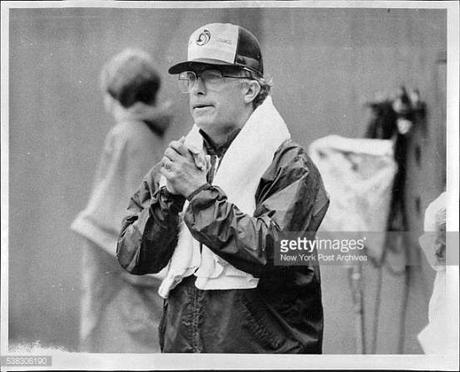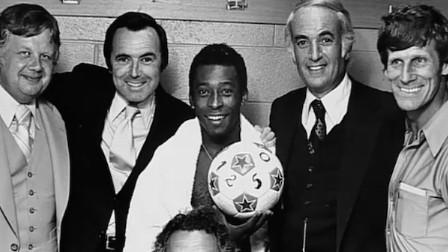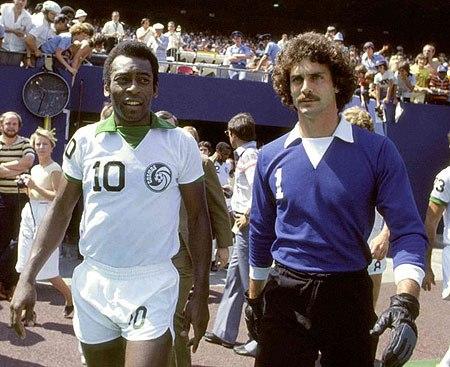 Professor Julio Mazzei (Photo: Getty Images)
Professor Julio Mazzei (Photo: Getty Images)Dénouement: Decline and Fall
With Pelé’s departure, the North American Soccer League (NASL) and Warner Communications were able to negotiate a contract with ABC television to broadcast regular network showings of league games, with a concentration on the Cosmos. Hand in hand with this arrangement, there were the requisite tailgate parties, barbecue outings, photo opportunities, the works. Giants Stadium was filled to capacity for nearly every game, a favorable omen.
But there are rules to be obeyed, and tried-and-true formulas to respect. One of them is: you can’t have one great team, with every other team in the league a bunch of losers and nobodies. Without reliable opposition you lose your competitive edge, that ability to test yourself, to prove yourself worthy against a strong-minded foe.
In 1978, the NASL expanded to twenty-four teams. Conversely, while the Cosmos themselves were getting better and better, the quality of play went down everywhere else. There were teams formed in Texas and Hawaii, even in Edmonton, Alberta, Canada, places the NASL had no business being in. As for the Cosmos, they were constantly on the road, with translators, limos, hotel bookings, etc., all on the company dole. There were numerous league records being set for goals, victories, and attendance, but to what end?
To victory in 1978, that’s what! And ABC Sports and their award-winning announcer Jim McKay covered it. By 1979, Chinaglia was calling the shots. He put together the team, the so-called “shadow government” (or the man behind the curtain, in David Hirshey’s words), with Coach Firmani and a fellow named Peppe Pinton in tow. A photograph is fleetingly flashed on the screen showing a beaming Steve Ross, Chinaglia in half-shadow in the center with his face turned to the side, Professor at far right in wide-framed glasses, and João Havelange, president of FIFA from 1974 to 1998 (1:19:45 to 1:19:46).
True, the Cosmos were racheting up victories, and Giorgio was busy scoring goals — a win-win situation for all, one would assume. That is, until the team ran into the Vancouver White Caps and the infamous shootout phase. Five seconds left, Nelsi Morais beat the goalie to the punch. Nelsi scores! But time had run out for the Cosmos, and for the league.
Poor scheduling (a matchup at high noon on a hot and humid Saturday in July) led to even poorer TV ratings. After one year ABC canceled their contract. That spelled doom not only for the team but for the entire league. Back-biting, finger-pointing, and infighting resulted. Everybody blamed the man in charge, Chinaglia, for the debacle. A convenient enough scapegoat, according to his detractors, but the truth was far more complicated.
In 1982, the Cosmos won their fifth title, then under Mazzei’s stewardship. The team photo (at 1:24:10 to 1:24:17) shows the Professor, smiling and bespectacled as was his nature, seated strategically between Chinaglia and Beckenbauer (keeping the “giants” at bay, so to speak), just as the NASL was collapsing around them, the result of a bloated budget and the lack of a profitable television deal.

Atari, Warner Communication’s prize baby, had crashed and burned, a one-day billion-dollar loss, leaving in its wake a “tsunami of red ink” that Ross could not ignore. One of the last full team shots in the documentary (panning from left to right at 1:25:01 to 1:25:06) features everyone from Jay Emmett and Steve Ross to the Ertegun brothers. But there was no sign of the Professor. With that, Warner started to trim the fat.
Also in 1982, Colombia had withdrawn as the host nation for the 1986 World Cup competition. An enthusiastic Ross campaigned hard to get the tournament staged for the first time ever in North America, a sign of soccer’s growing influence and importance in the northern hemisphere. It was here that Professor Mazzei was called back into action. We see another photo of Steve Ross, similar to the one above of Ross, Chinaglia, and Havelange, only this time with a slight portion of Professor’s face (at 1:26:08 to 1:26:11), from his left eye up to his head, being exposed — emblematic, one would think, of his behind-the-scenes position. Despite the politicking and glad-handing, the bid went to Mexico (they had previously hosted the contest in 1970). No explanation was given for the turndown.
In 1984, the Cosmos was dissolved.
A group shot (from 1:28:16 to 1:28:20) includes, from left to right, Clive Toye, Jay Emmett, Steve Ross, and Gordon Bradley, surrounding the ever-smiling Pelé, who occupies the central slot. He is holding the NASL soccer ball in the palm of his hand — the “King” displaying his scepter. Just below the ball, squatting in front and cut off from just below eye level, is the distinctive visage of Professor Julio Mazzei.

Unable to speak for himself, Professor is there in spirit. His presence continued to be felt as the team’s trainer and board member, as well as a spokesperson not just for the Cosmos but for the sport itself. Only his upper forehead remains visible — photographically speaking (and as far as the Cosmos were concerned), only half as significant an individual as he used to be. But all that work wasn’t in vain.
“The legacy of the Cosmos would be that they lay the seeds for every player that plays in this country today.” Thus spoke former Cosmos goalie Shep Messing.
“Can you imagine a team like the Cosmos today?” quizzed Chinaglia appreciatively. “With the talent they had on the field? It would be worth a billion dollars!”
Steve Ross passed away in 1992. He never saw the World Cup come to the U.S. in 1994. The film’s signoff affirms that “After the success of the 1994 World Cup, a new league, the Major League Soccer (MLS) was formed in 1996. The US National Team has qualified for every World Cup since 1990.”
Pelé, the lone superstar at the start and the world’s greatest soccer player before and after his time with the team, declined to be interviewed for the documentary (his salary demands alone would have exceeded the film’s budget). His testimony wasn’t needed, however, for without a doubt his one shot at popularizing the sport in the U.S. can be deemed a qualified success.

It was indeed a “once in a lifetime” achievement, an extraordinary story of a team and a league that rose from the ashes of its own destruction to become a major force in American sports. That achievement involved a number of individuals, among them the ever-present Professor Julio Mazzei.
I learned later from Professor’s daughter, Marjorie Mazzei Raggo, the reason for her father’s absence as an interview subject: by the time the documentary was being shot and edited, her father had come down with Alzheimer’s disease. “He no longer recognizes me or even speaks, much less talks about futebol. Can you believe it?”
Julio Mazzei passed away on May 10, 2009, in the seaside resort city of Santos where he and Pelé first crossed paths.
One of the last scenes in the documentary (at 1:31:23 to 1:31:31) brings back one of the earliest ones: that of Pelé being hugged by his teammates, Steve Hunt and Nelsi Morais, with an exuberant Professor Mazzei alongside as celebrant and supporter — the very symbol of joy and passion for the game, of an enthusiasm borne of sheer love for the sport; a childlike purity and naiveté that can only be captured by film and by those who knew him personally. Although his name is nowhere to be found in the opening or closing credits, Mazzei’s handiwork is evident from start to finish.
With arms raised in triumph, all hats are off to the man behind the glasses. Not only was he friends with the great Pelé, he was everyone’s friend in soccer. ☼
Copyright © 2017 by Josmar F. Lopes
Advertisements
